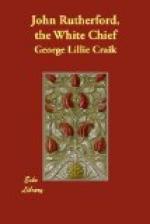In general, however, the New Zealanders are a tall race of men, many of the individuals belonging to the upper classes being six feet high and upwards. They are also described as strong, active, and almost uniformly well-shaped. Their hair is commonly straight, but sometimes curly; Crozet says he saw a few of them with red hair. Cook describes the females as far from attractive; but other observers give a more flattering account of them. Savage, for example, assures us that their features are regular and pleasing; and he seems to have been much struck by their “long black hair and dark penetrating eyes,” as well as “their well-formed figure, the interesting cast of their countenance, and the sweet tone of their voice.” Cruise’s testimony is almost equally favourable.
The dress of the two sexes is exactly the same, and consists of an inner mat or tunic, fastened by a girdle round their waists, and an upper cloak, which is made of very coarse materials for ordinary wear, but is of a much finer fabric, and often, indeed, elaborately ornamented, when intended for occasions of display. Both these articles of attire are always made of the native flax. The New Zealanders wear no covering either for the head or the feet, the feathers with which both sexes ornament the head being excepted.
The food upon which they principally live is the root of the fern-plant, which grows all over the country.
Rutherford’s account of the method of preparing it, which we have already transcribed, corresponds exactly with that given by Cook, Nicholas, and others. This root, sometimes swallowed entirely, and sometimes only masticated, and the fibres rejected after the juice has been extracted, serves the New Zealanders not only for bread, but even occasionally for a meal by itself. When fish are used, they do not appear, as in many other countries, to be eaten raw, but are always cooked, either by being fixed upon a stick stuck in the ground, and so exposed to the fire, or by being folded in green leaves, and then placed between heated stones to bake. But little of any other animal food is consumed, birds being killed chiefly for their feathers, and pigs being only produced on days of special festivity.
The first pigs were left in New Zealand by Cook, who made many attempts to stock the country both with this and other useful animals, most of whom, however, were so much neglected that they soon disappeared. Cook, likewise, introduced the potato into New Zealand; and that valuable root appears to be now pretty generally cultivated throughout the northern island.
The only agricultural implements, however, which the natives possess are of the rudest description; that with which they dig their potatoes being merely a wooden pole, with a cross-bar of the same material fixed to it about three feet from the ground. Marsden saw the wives of several of the chiefs toiling hard in the fields with no better spade than this; among others the head wife of the great Shungie, who, though quite blind, appeared to dig the ground, he says, as fast as those who had their sight, and as well, first pulling up the weeds as she went along with her hands, then setting her feet upon them that she might know where they were; and, finally, after she had broken the soil, throwing the mould over the weeds with her hands.




